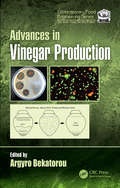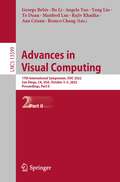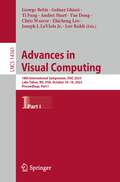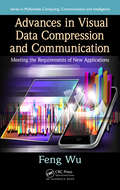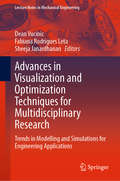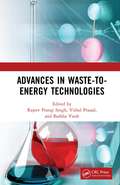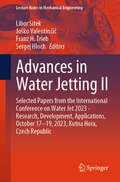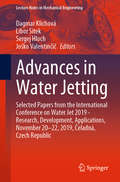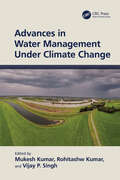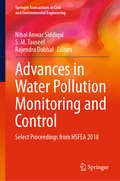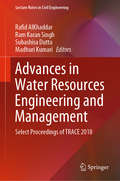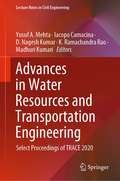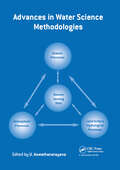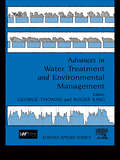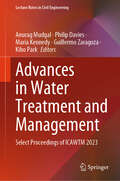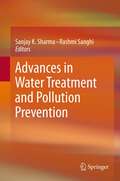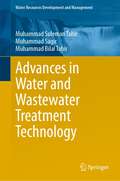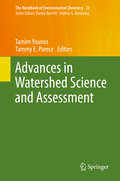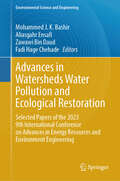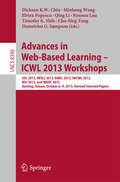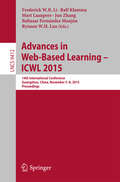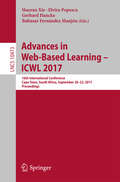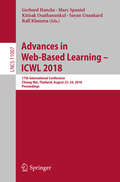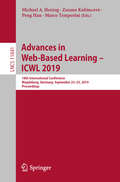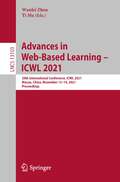- Table View
- List View
Advances in Vinegar Production (Contemporary Food Engineering #1)
by Argyro BekatorouIn industrial vinegar production, there are three main types of methods involved; the slow, handcrafted, traditional method ("Orleans" or "French" method), and the rapid submerged and generator methods. The current trend is to fuse traditional techniques with state-of-the-art technologies, and a variety of approaches have been developed to increase fermentation efficiency and reduce cost and fermentation time. This book reports on all the recent innovations in vinegar production, and compares them to the traditional submerged fermentation systems. The new trends on raw materials, substrate pretreatment strategies, alcoholic fermentation, and acetitification systems are also reviewed.
Advances in Visual Computing: 17th International Symposium, ISVC 2022, San Diego, CA, USA, October 3–5, 2022, Proceedings, Part II (Lecture Notes in Computer Science #13599)
by Yang Liu George Bebis Bo Li Manfred Lau Angela Yao Ye Duan Rajiv Khadka Ana Crisan Remco ChangThis two-volume set of LNCS 13598 and 13599 constitutes the refereed proceedings of the 17th International Symposium on Visual Computing, ISVC 2022, which was held in October 2022. The 61 papers presented in these volumes were carefully reviewed and selected from 110 submissions. They are organized in the following topical sections: Part I: deep learning I; visualization; object detection and recognition; deep learning II; video analysis and event recognition; computer graphics; ST: biomedical imaging techniques for cancer detection, diagnosis and management.Part II: ST: neuro-inspired artificia intelligence; applications; segmentation and tracking; virtual reality; poster.
Advances in Visual Computing: 18th International Symposium, ISVC 2023, Lake Tahoe, NV, USA, October 16–18, 2023, Proceedings, Part I (Lecture Notes in Computer Science #14361)
by Yue Dong George Bebis Luv Kohli Joseph J. LaViola Jr. Yi Fang Golnaz Ghiasi Andrei Sharf Chris Weaver Zhicheng LeoThis volume LNCS 14361 and 14362 constitutes the refereed proceedings of the, 16th International Symposium, ISVC 2023, in October 2023, held at Lake Tahoe, NV, USA.The 42 full papers and 13 poster papers were carefully reviewed and selected from 120 submissions. A total of 25 papers were also accepted for oral presentation in special tracks from 34 submissions. The following topical sections followed as:Part 1: ST: Biomedical Image Analysis Techniques for Cancer Detection, Diagnosis and Management; Visualization; Video Analysis and Event Recognition; ST: Innovations in Computer Vision & Machine Learning for Critical & Civil Infrastructures; ST: Generalization in Visual Machine Learning; Computer Graphics; Medical Image Analysis; Biometrics; Autonomous Anomaly Detection in Images; ST: Artificial Intelligence in Aerial and Orbital Imagery; ST: Data Gathering, Curation, and Generation for Computer Vision and Robotics in Precision Agriculture.Part 2: Virtual Reality; Segmentation; Applications; Object Detection and Recognition; Deep Learning; Poster.
Advances in Visual Data Compression and Communication: Meeting the Requirements of New Applications (Multimedia Computing, Communication and Intelligence #5)
by Feng WuThis book provides a theoretical and technical basis for advanced research on visual data compression and communication. It presents the results of the author's research on visual data compression and transmission. Studying scalable video coding (SVC), it considers the fundamental problem to be solved in SVC-motion compensation. It explores directional transforms, extends the current coding framework by visual synthesis and reconstruction, and explains how to apply compressive sensing to solve the compression problems in transmission. It also develops the pseudo-analog transmission for image and video.
Advances in Visualization and Optimization Techniques for Multidisciplinary Research: Trends in Modelling and Simulations for Engineering Applications (Lecture Notes in Mechanical Engineering)
by Fabiana Rodrigues Leta Dean Vucinic Sheeja JanardhananThis volume presents several multidisciplinary approaches to the visual representation of data acquired from experiments. As an expansion of these approaches, it is also possible to include data examination generated by mathematical-physical modeling. Imaging Systems encompass any subject related to digital images, from fundamental requirements for a correct image acquisition to computational algorithms that make it possible to obtain relevant information for image analysis. In this context, the book presents selected contributions of a special session at the Conference on Advanced Computational Engineering and Experimenting (ACE-X) 2016.
Advances in Waste-to-Energy Technologies
by Rajeev Pratap Singh Vishal Prasad Barkha VaishAs global populations continue to increase, the application of biotechnological processes for disposal and control of waste has gained importance in recent years. Advances in Waste-to-Energy Technologies presents the latest developments in the areas of solid waste management, Waste-to-Energy (WTE) technologies, biotechnological approaches, and their global challenges. It combines biotechnological procedures, sophisticated modeling, and techno-economic analysis of waste, and examines the current need for the maximum recovery of energy from wastes as well as the associated biotechnological and environmental impacts. Features: Presents numerous waste management practices and methods to recover resources from waste using the best biotechnological approaches available. Addresses the challenges, management, and policy issues of waste management and WTE initiatives. Includes practical case studies from around the world. Serves as a useful resource for professionals and students involved in cross-disciplinary and trans-disciplinary research programs and related courses. Discusses the economic and regulatory contexts for managing waste. This book will serve as a valuable reference for researchers, academicians, municipal authorities, government bodies, waste managers, building engineers, and environmental consultants requiring an understanding of waste management and the latest WTE technologies.
Advances in Water Jetting II: Selected Papers from the International Conference on Water Jet 2023 - Research, Development, Applications, October 17-19, 2023, Kutna Hora, Czech Republic (Lecture Notes in Mechanical Engineering)
by Sergej Hloch Libor Sitek Joško Valentinčič Franz H. TriebThis book gathers selected, peer-reviewed contributions to the international conference on Water Jet 2023 (WJ2023), organized by the Institute of Geonics of the Czech Academy of Sciences. It covers research and developments of water jets, and their applications in cutting, machining, cleaning, surface treatment, and milling. Further topics include the use of water jets in the removal of coatings and layers, jet grouting, jet observation and parameters measurement. Moreover, erosion wear, environmental aspects of water jets and their improvement with particular emphasis on sustainable practices, are also discussed. Overall, this book provides academics and practitioners with extensive information on state-of-the-art theories and methods that can be used to understand, analyse and improve the rapidly growing field high-velocity water jet technology.
Advances in Water Jetting: Selected Papers from the International Conference on Water Jet 2019 - Research, Development, Applications, November 20-22, 2019, Čeladná, Czech Republic (Lecture Notes in Mechanical Engineering)
by Sergej Hloch Dagmar Klichová Libor Sitek Joško ValentinčičThis book reports on recent advances in the rapidly growing field of high-speed water jet technology, discussing research, developments and applications related to cutting, machining, repair of structures and buildings, cleaning, removal of coatings and layers, mining, and abrasive materials. It also explores special applications of high-pressure techniques, as well as important environmental aspects and solutions for technology transfer. Thanks to the balance of theory and practical findings, the book offers a timely snapshot for researchers and industrial communities alike, and a platform to facilitate communication and collaboration between the two groups.
Advances in Water Management Under Climate Change
by Vijay P. Singh Rohitashw Kumar Mukesh KumarDue to increasing population, decreased cultivable land, and mounting scarcity of water, it is essential to optimize the use of available resources. Climate change is occurring across the world but its effect may be local or region-specific, including localized watershed management. In order to minimize these effects, governments and environmental agencies encourage the adoption of "climate-smart" agricultural technologies, which involve implementing plans, programs, and projects to sustain and enhance watersheds. Natural ecosystems, in their altered states, have always been relied upon to support the continuity of agricultural production and ecosystem services, such as flood and erosion control, mediation of water quality, stream flow regulation, microclimate regulation, and biodiversity in its various forms. According to the Food and Agriculture Organization of the United Nations, the adoption of these sustainable water management practices has resulted in savings of water and energy as well as a reduction of carbon emissions, decreased erosion, increased organic matter content and biotic activity in soils, increased crop water availability and thus resilience to drought, improved recharge of aquifers, and reduced impact of the variability in weather due to climate change. Advances in Water Management Under Climate Change examines all of these issues and provides best practices for sustainability. Features: Presents the latest research in hydrology, hydraulics, water resources engineering, and agricultural best practices Examines water management practices to best address and ideally mitigate climate change Explains the nexus of agriculture, micro irrigation, AI applications in water management, and the impact of climate change on water resources Includes practical examples to present practical insights on water management for climate change mitigation.
Advances in Water Pollution Monitoring and Control: Select Proceedings from HSFEA 2018 (Springer Transactions in Civil and Environmental Engineering)
by S. M. Tauseef Nihal Anwar Siddiqui Rajendra DobhalThis book presents the proceedings of the International Conference on Health, Safety, Fire, Environment, and Allied Sciences (HSFEA 2018), highlighting the latest developments in the field of science and technology aimed at improving health and safety in the workplace. The volume comprises content from leading scientists, engineers, and policy makers, discussing water pollution and advanced remedial measures, and the impact on health and the environment. Topics of discussion include research on emerging water pollutants, their sources, monitoring and control. The contents of this volume will be of interest to researchers, practitioners, and policy makers alike.
Advances in Water Resources Engineering and Management: Select Proceedings of TRACE 2018 (Lecture Notes in Civil Engineering #39)
by Madhuri Kumari Rafid AlKhaddar Ram Karan Singh Subashisa DuttaThis book comprises select papers presented at the International Conference on Trends and Recent Advances in Civil Engineering (TRACE 2018). The book covers inter-disciplinary research and applications in integrated water resource management, river ecology, irrigation system, water pollution and treatment, hydraulic structure and hydro-informatics. The topics on water resource management include technological intervention and solution for climate change impacts on water resources, water security, clean water to all, sustainable water reuse, flood risk assessment, interlinking of rivers and hydro policy. The contents of this book will be useful to researchers and professionals working in the field of water resource management and related policy making.
Advances in Water Resources and Transportation Engineering: Select Proceedings of TRACE 2020 (Lecture Notes in Civil Engineering #149)
by D. Nagesh Kumar Madhuri Kumari Yusuf A. Mehta Iacopo Carnacina K. Ramachandra RaoThis book comprises select proceedings of the International Conference on Trends and Recent Advances in Civil Engineering (TRACE 2020). The volume focuses on latest research works carried out in the area of water resources and transportation engineering. The topics include technological intervention and solution for water security, sustainability in water resources and transportation infrastructure, crop protection, resilience to disaster like flood, hurricane and drought, traffic congestion, transport planning etc. It aims to address broad spectrum of audience by covering inter-disciplinary innovative research and applications in these areas. It will be useful to graduate students, researchers, scientists, and practitioners working in water resources and transportation engineering domain.
Advances in Water Science Methodologies
by U. AswathanarayanaThis book is a useful guide to employing remote sensing data to explain and illustrate interactions between atmospheric, oceanic and hydrological processes, incorporating the latest developments in the field. A number of applications, such as water resources management, environmental monitoring, climate prediction, agriculture, and preparation
Advances in Water Treatment and Environmental Management: Proceedings Of The 1st International Conference
by Roger King George ThomasProceedings of the 1st International Conference, Lyon, France, 27-29 June 1990.This book presents the specialist and those less familiar with water treatment and environmental management with up to date information from a range of international workers. The conference was a forum at which interest groups representing the research community, water c
Advances in Water Treatment and Management: Select Proceedings of ICAWTM 2023 (Lecture Notes in Civil Engineering #536)
by Philip Davies Guillermo Zaragoza Anurag Mudgal Maria Kennedy Kiho ParkThis book presents the select proceedings of International Conference on Advances in Water Treatment and Management (ICAWTM 2023). It covers the recent trends in water treatment processes. Various topics covered include innovative process developments in water treatment, renewable energy-assisted desalination processes, conceptual design, and process hybridization for water treatment. The book is highly useful for researchers and professionals in the fields of water treatment, renewable energy, industrial chemistry, and many other allied fields.
Advances in Water Treatment and Pollution Prevention
by Rashmi Sanghi Sanjay K. SharmaAdvances in Water Treatment and Pollution Prevention explores the most up-to-date studies in the field of water pollution. More specifically, this book examines the causes and effects of this threatening phenomenon and identifies the preventive measures that can be taken to contain, and even to defeat, water pollution worldwide. The papers gathered in this volume pinpoint the need to implement greener water treatments to prevent water pollution from impacting ecosystems, human well-being and economies any further. They also successfully outline the processes that have been studied, optimized and developed so far to sustain our environment. Advances in Water Treatment and Pollution Prevention will represent a valuable resource to academic researchers, students, institutions, environmentalists, and anyone interested in environmental policies aimed at safeguarding both the quality and the quantity of water.
Advances in Water and Wastewater Treatment Technology (Water Resources Development and Management)
by Muhammad Sagir Muhammad Bilal Tahir Muhammad Suleman TahirThis book highlights the several pollutants and their derivatives that exist in water and wastewater, such as pharmaceuticals, antibiotics, personal care products, heavy metals, pesticides, dyes etc., as a result of rapid urbanization and industrialization. Several part pollution is caused by nutrients, organics, and contaminants with low concentration but is highly toxic to human and aquatic environment. This book provides a holistic approach in terms of measurement, monitoring, and recent advances in treatment technologies for water and wastewater treatment and water reuse. The technologies involve the physio-chemical, biological and advanced oxidation processes in which they are modified or coupled with nanomaterials and/or newly developed products for improving the performance of the current treatment processes. In addition, the membrane processes include recent research on the removal of challenging chemicals by various membrane bioreactors and reverse osmosis processes.
Advances in Watershed Science and Assessment (The Handbook of Environmental Chemistry #33)
by Tamim Younos Tammy E. PareceThis volume offers concepts, methods and case studies of innovative and evolving technologies in the area of watershed assessment. Topics discussed include: (1) Development and applications of geospatial, satellite imagery and remote sensing technologies for land monitoring; (2) Development and applications of satellite imagery for monitoring inland water quality; (3) Development and applications of water sensor technologies for real-time monitoring of water quantity and quality; and (4) Advances in biological monitoring and microbial source tracking technologies. This book will be of interest to graduate students and researchers involved in watershed science and environmental studies. Equally, it will serve as a valuable guide to experts in government agencies who are concerned with water-availability and water-quality issues, and engineers and other professionals involved in the design of land- and water-monitoring systems.
Advances in Watersheds Water Pollution and Ecological Restoration: Selected Papers of the 2023 9th International Conference on Advances in Energy Resources and Environment Engineering (Environmental Science and Engineering)
by Fadi Hage Chehade Zawawi Bin Daud Mohammed J. K. Bashir Aliasgahr EnsafiThis book provides a glimpse into the cutting-edge research on pollution management and detection in the water environments of watersheds, covering topics like water pollution traceability, pollution monitoring, and management techniques. According to the United Nations World Water Development Report provided by the World Water Forum, millions of tons of garbage are dumped into rivers, lakes, and streams around the world every day, and every liter of wastewater pollutes eight liters of freshwater, causing a serious damage to the water environment in watersheds. The protection and prevention of water in watersheds, which is related to freshwater resources for human development and survival, has always been a crucial research direction in the field of environmental engineering. This book aims to promote the exchange of scientific information among scholars from the world's leading universities, research centers, and high-tech companies and is of great benefit to researchers and professionals in the field of environmental control of watershed management.
Advances in Web-Based Learning - ICWL 2013 Workshops: USL 2013, IWSLL 2013, KMEL 2013, IWCWL 2013, WIL 2013, and IWEEC 2013, Kenting, Taiwan, October 6-9, 2013, Revised Selected Papers (Lecture Notes in Computer Science #8390)
by Demetrios G. Sampson Qing Li Dickson K. W. Chiu Elvira Popescu Minhong Wang Rynson Lau Timothy K. Shih Chu-Sing YangThis book constitutes the refereed proceedings of the Workshops held at the ICWL 2013 International Conference on Web Based Learning in Kenting, Taiwan, in October 2013. The 29 papers presented were carefully reviewed and selected for inclusion in this volume. They were held at the following workshops: First International Workshop on Ubiquitous Social Learning, USL 2013; 2013 International Workshop on Smart Living and Learning, IWSLL 2013; Third International Symposium on Knowledge Management and e-Learning, KMEL 2013; 2013 International Workshop on Cloud Computing for Web-Based Learning, IWCL 2013; 2013 International Workshop on Web Intelligence and Learning; WIL 2013; and the 2013 International Workshop on e-book and Education Cloud, IWEEC 2013.
Advances in Web-Based Learning -- ICWL 2015: 14th International Conference, Guangzhou, China, November 5-8, 2015, Proceedings (Lecture Notes in Computer Science #9412)
by Jun Zhang Frederick W.B. Li Ralf Klamma Mart Laanpere Baltasar Fernández Manjón Rynson W.H. LauThis book constitutes the refereed proceedings of the 14th International Conference on Web-Based Learning, ICWL 2015, held in Guangzhou, China, in Noavember 2015. The 18 revised full papers presented together with 2 invited papers and 7 short papers were carefully reviewed and selected from about 79 submissions. The papers are organized in topical sections on collaborative and peer learning; e-lerning platform and tolls; design, model, and framework of e-learning systems; intelligent tutoring and tools; pedagogical issues; personalized and adaptive learning; and Web 2. 0 and social learning environments.
Advances in Web-Based Learning – ICWL 2017: 16th International Conference, Cape Town, South Africa, September 20-22, 2017, Proceedings (Lecture Notes in Computer Science #10473)
by Baltasar Fernández Manjón Elvira Popescu Haoran Xie Gerhard HanckeThis book constitutes the proceedings of the 16th International Conference on Web-Based Learning, ICWL 2017, held in Cape Town, South Africa, in September 2017. The 13 revised full papers presented together with 9 short papers and 3 poster papers were carefully reviewed and selected from 56 submissions. The papers are organized in topical sections on Inquiry-Based Learning and Gamification; Learning Analytics; Social Media and Web 2. 0-based Learning Environments; Assessment and Accessibility in Higher Education; Open Educational Resources and Recommender Systems; and Practice and Experience Sharing.
Advances in Web-Based Learning – ICWL 2018: 17th International Conference, Chiang Mai, Thailand, August 22-24, 2018, Proceedings (Lecture Notes in Computer Science #11007)
by Ralf Klamma Marc Spaniol Gerhard Hancke Kitisak Osathanunkul Sayan UnankardThis book constitutes the proceedings of the 17th International Conference on Web-Based Learning, ICWL 2018, held in Chiang Mai, Thailand, in August 2018.The 11 revised full papers presented together with 4 short papers were carefully reviewed and selected from 37 submissions. The papers are organized in topical sections on learning assessment and behavior; case studies; augmented reality and collaborative learning; game-based learning; and learning content management and experience sharing.
Advances in Web-Based Learning – ICWL 2019: 18th International Conference, Magdeburg, Germany, September 23–25, 2019, Proceedings (Lecture Notes in Computer Science #11841)
by Marco Temperini Michael A. Herzog Zuzana Kubincová Peng HanThis book constitutes the proceedings of the 18th International Conference on Advances in Web-Based Learning, ICWL 2019, held in Magdeburg, Germany, in September 2019. The 15 full, 15 short, and 7 poster papers presented in this volume were carefully reviewed and selected from 68 submissions. The contributions were organized in topical sections named: Semantic Web for E-Learning, Learning Analytics, Computer Supported Collaborative Learning, Assessment and Pedagogical Issues, E-learning Platforms and Tools, Mobile Learning, and Poster Papers.
Advances in Web-Based Learning – ICWL 2021: 20th International Conference, ICWL 2021, Macau, China, November 13–14, 2021, Proceedings (Lecture Notes in Computer Science #13103)
by Wanlei Zhou Yi MuThis book constitutes the proceedings of the 20th International Conference on Advances in Web-Based Learning, ICWL 2021, which was held in Macau, China, in November 2021. The papers included in this volume deal with multiple topics, from algorithms to systems and applications and are organized in 3 tracks: Online learning methodologies, trust, and analysis; Online learning environment with tools; Online learning privacy issues and special tools.
